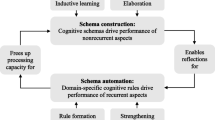Abstract
Traditional computer simulations do not incorporate human intuition and human-like engagement that acknowledges complex and abstract questions. This paper presents WOTS (Wizard of Oz Telemedicine Simulator), a generic cognitive training platform that supports transfer of medical knowledge through remote training and consultations (telemedicine training). Medical training via the WOTS provides remote learners a risk-free environment in which they can practice and make mistakes, while receiving online feedback about their decisions. WOTS leverages the Wizard of Oz (WOZ) concept, where human intuition is applied through corrective feedback to complex and abstract misconceptions of learners’ thinking (flawed mental models). The contribution of WOTS to enhanced learning is demonstrated by a number of pilot runs and a case study.






Similar content being viewed by others
References
Amavel R, Cruz-Correia R and Frias-Bulhosa J (2009) Remote diagnosis of children dental problems based on non-invasive photographs: A Valid Proceeding. In Medical Informatics in a United and Healthy Europe 2009 (Adlassnig KP, Blobel B, Mantas J and Masic I, Eds), pp 458–462, IOS Press, Amsterdam, the Netherlands.
Bangert D, Doktor R and Johnson E (2001) Designing web-based telemedicine training for military health care providers. Journal of Continuing Education in the Health Professions 21 (3), 162–169.
Blignault I and Kennedy C (1999) Training for telemedicine. Journal of Telemedicine & Telecare 5 (Supplement 1), 112.
Davidovitch L, Parush A and Shtub A (2010) Simulator-based team training to share resources in a matrix structure organization. IEEE Transactions on Engineering Management 57 (2), 288–230.
Gaba DM (2004) The future vision of simulation in health care. Quality and Safety in Health Care 13 (Suppl. 1), i2–i10.
Geissbuhler A, Bagayoko CO and Ly O (2007) The RAFT network: 5 years of distance continuing medical education and tele-consultations over the internet in French-speaking Africa. International Journal of Medical Information 76 (5–6), 351–356.
Hoheisel J, Weber F and Windhoff G (2000) New approaches for training and education of engineers by using simulation games. In Games in Operations Management (Riis JO, Smeds R and van Landegehem R, Eds), pp 99–110, Kluwer, London.
Issenberg SB, McGaghie WC, Petrusa ER, Gordon DL and Scalese RJ (2005) What are the features and uses of high-fidelity medical simulations that lead to most effective learning? BEME guide no 4. Medical Teacher 27 (1), 10–28.
Klein G and Baxter HC (2009) Cognitive transformation theory: contrasting cognitive and behavioral learning. In The PSI Handbook of Virtual Environments for Training and Education: Developments for the Military and Beyond, Education: Learning, Requirements and Metrics (Schmorrow D, Cohen J and Nicholson D, Eds), pp 50–65, Praeger, Westport, CT.
Leutner D (1993) Guided discovery learning with computer-based simulation games: effects of adaptive and non-adaptive instructional support. Learning and Instruction 3 (2), 113–132.
Nevo B and Zakay A (1992) Development of trainees’ feedback system. In Command and Staff College. Israel Defense Forces, Tel Aviv.
Rieser V, Kruijff-KorbayovÁ I and Lemon O (2005) A corpus collection and annotation framework for learning multimodal clarification strategies. In Proceedings of the Sixth SIGdial Workshop on Discourse and Dialogue, pp 97–106, Lisbon, Portugal.
Salas E, Wildman JL and Piccolo RF (2009) Using simulation-based training to enhance management education. Academy of Management Learning & Education 8 (4), 559–573.
Spooner SA and Gotlieb EM (2004) Telemedicine: pediatric applications. Pediatrics 113 (6), e639–e643.
Steele A. (2010) Next generation project management simulation. National Advisory Committee on Computing Qualifications (NACCQ). Journal of Applied Computing and Information Technology 14 (1), 39–44.
Author information
Authors and Affiliations
Corresponding author
Appendices
Appendix A
Questionnaire 1 – before the workshop
‘Using Simulation-based Training (SBT) to Enhance Management Education’, by Salas, Wildman and Piccolo, Academy of Management Learning and Education, Volume 8, Number 4, December 2009.

Appendix B
Questionnaire 1 – post training (training effectiveness)

Appendix C

Rights and permissions
About this article
Cite this article
Katz, A., Basis, F. & Shtub, A. Using Wizard of Oz technology for telemedicine. Health Syst 4, 224–235 (2015). https://doi.org/10.1057/hs.2014.23
Received:
Revised:
Accepted:
Published:
Issue Date:
DOI: https://doi.org/10.1057/hs.2014.23




